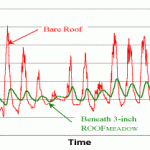
Additional Resources
Visit the Fencing Academy of Philadelphia website. Learn more about Roofscapes in The Greenroof Directory. For more information about this project, visit Roofscapes, Inc. here.See the related Philadelphia Weekly article “Roof Positive” by Cassidy Hartmann of 8.23.06 here and the Philadelphia Inquirer article of 2.0207 entitled “Green on high” by Virginia A. Smith and read the 2000 US EPA’s Vegetated Roof Cover Fact Sheet containing specific info about the Fencing Academy greenroof here.
The Fencing Academy of Philadelphia is one of the top four fencing facilities in the U.S. Roofscapes, Inc.?s first installation is an extensive 3,000 square foot (279 m?) greenroof with a meadow-like setting of perennial sedum varieties on the Fencing Academy of Philadelphia. Designed to reduce the intense glare of the white roof of founder Mark Masters’ apartment which overlooked the barren shiny roof, the Fencing Academy of Philadelphia decided on a vegetated roof, utilizing the Roofmeadow? Type II: Aromatic Garden prototype.The performance objective also was the restoration of pre-development runoff peak rates for the 2-year return-frequency storm. The vegetated cover of “sprigged” or cut sedums with spot plantings was selected to withstand the range of seasonal conditions typical of the mid-Atlantic region without the need for regular maintenance.
The Philadelphia Roof Cover is only 3.4″ thick, including the drain layer. It weighs less than 5 lb/sf when dry, with a maximum saturated weight of under 17 lb/sf. The moisture content of the soil media at field capacity is 45% (volume), and the saturated infiltration capacity is 3.5 in/hr. The design was evaluated using proprietary software developed by Optima. The Philadelphia Fencing Academy greenroof has been continuously monitored for temperature readings, along with an adjacent roof without a vegetated roof cover. During the spring and summer, the daily variation in temperature on the bare roof ranges up to 90 degrees F (50 degrees C), while the variation under the vegetative cover is only 18 degrees F (10 degrees C), or less.
 Greenroofs.comConnecting the Planet + Living Architecture
Greenroofs.comConnecting the Planet + Living Architecture












